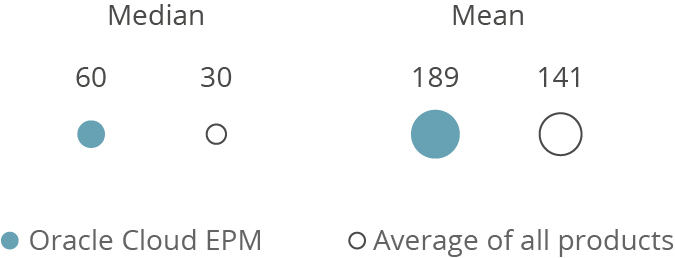Oracle Cloud EPM
Oracle is a global provider of enterprise cloud computing, offering software, platform, infrastructure and data as a service. The company employs more than 170,000 people worldwide and serves 430,000 customers in 175 countries.
Oracle’s portfolio includes a comprehensive stack of cloud applications, platform services and engineered systems. The vendor’s cloud enterprise performance management (EPM) and analytics portfolios contain a comprehensive set of strategic offerings, which are packaged as Oracle Fusion Cloud EPM and Oracle Analytics Cloud. However, the company’s widely used on-premises solutions (e.g., Oracle Hyperion EPM) continue to be enhanced and fully supported. A variety of other cloud and on-premises offerings and applications complete Oracle’s broad product portfolio.
Oracle’s comprehensive EPM portfolio includes various products and applications covering all relevant EPM processes (e.g., planning, budgeting and forecasting, profitability and cost management, financial consolidation and close, account reconciliation, tax provision and reporting, transfer pricing and enterprise data management). The vendor’s entire EPM portfolio is available in the cloud. All Oracle Cloud EPM solutions are based on a consistent technical platform architecture and can be deployed in a modular fashion according to customer needs and priority. For data integration from data sources, Oracle Cloud EPM provides native, wizard-based features including predefined connectors to Oracle and non-Oracle operational systems (e.g., ERPs). For customers who prefer to manage EPM applications on-premises, Oracle’s Hyperion EPM portfolio is still available (e.g., Oracle Hyperion Planning for planning, budgeting and forecasting or Oracle Hyperion Financial Management for financial consolidation and close). Oracle Cloud EPM has some ‘shared DNA’ with the on-premises Oracle Hyperion EPM portfolio, for example, leveraging the optional Microsoft Office add-in Oracle Smart View to work in Excel, Word and PowerPoint across both cloud and on-premises.
In terms of planning, budgeting and forecasting, Oracle Cloud EPM offers a broad range of capabilities for enterprise-wide integrated business planning processes – including connected operational, financial and strategic planning as well as scenario simulations. Prebuilt modules and solutions expand the reach of Oracle’s planning solution beyond finance into sales, workforce, IT, marketing and supply chain operations. To support users with tasks such as predictions, simulations and correlations, and to automatically find insights and take actions, Intelligent Performance Management (IPM) is a major area of continued investment for Oracle. Several statistical and ML features are embedded in Oracle Cloud EPM including support for integrating third-party ML models and ML engines. In addition, Oracle’s own data science platforms and ML algorithms embedded in Oracle databases can be leveraged.
Oracle’s flagship product for analytics, Oracle Analytics Cloud, incorporates business-user-oriented capabilities for the complete analytics cycle. It offers modules for developing and deploying formatted reports, interactive dashboards and analytics suitable for business users. Oracle Analytics Server, the on-premises version of Oracle Analytics Cloud, brings all the capabilities of the cloud platform to organizations requiring on-premises deployment options. In addition, Oracle Fusion Analytics offers embedded analytics within the vendor’s portfolio of business applications. With its EPM suite, Oracle has adopted the strategy of embedding analytics and reporting capabilities needed by a majority of customers and their users into the Cloud EPM platform as opposed to requiring customers to separately acquire Oracle Analytics Cloud.

User & Use Cases
89 percent of Oracle Cloud EPM users are planning users – significantly above the survey average of 69 percent – reflecting the fact that Oracle Cloud EPM offers comprehensive planning functionality as well as applications covering other EPM processes. This is also born out in its typical use cases. Customers leverage Oracle Cloud EPM for financial planning (90 percent) but also operational planning (64 percent). Here, planning takes place at different aggregation levels. Oracle Cloud EPM is used for budgeting (90 percent), forecasting (52 percent) and strategic planning (40 percent). Besides planning, customers mainly use it for ad hoc query (89 percent) and standard/enterprise reporting (78 percent). Many respondents also plan to use it for strategic planning (50 percent), dashboards/BI applications (44 percent) and forecasting (38 percent).
Oracle Cloud EPM targets mid-sized and large companies across all industries. 60 percent of our sample of Oracle Cloud EPM customers come from large companies (more than 2,500 employees) with a median of 70 users (including 60 using planning functionality), but the mean of 213 users (189 for planning) indicates there are also several larger implementations.
Current vs. planned use (planning use cases)
N=30

Current vs. planned use (besides planning)
N=28

Total number of users per company
N=30

Planning users per company
N=30

Percentage of employees using Oracle Cloud EPM
N=30

Planning users (as a percentage of all users)
N=30

Company size (number of employees)
N=30

Versions used
N=30

Want to see the whole picture?
BARC’s Vendor Performance Summary contains an overview of The Planning Survey results based on feedback from Oracle Cloud EPM users, accompanied by expert analyst commentary.
Contact us to purchase the Vendor Performance Summary- Register for a free sample Vendor Performance Summary download
- If you have any questions, feel free to contact us
